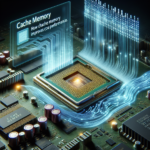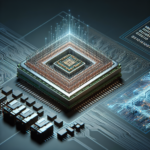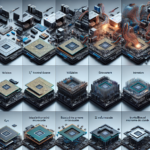Explaining the Use of CPUs in Advanced Driver Assistance Systems (ADAS)

Explaining the Use of CPUs in Advanced Driver Assistance Systems (ADAS)
Advanced Driver Assistance Systems (ADAS) are revolutionizing the automotive industry by enhancing vehicle safety and driving comfort. These systems rely heavily on sophisticated computing technologies, with Central Processing Units (CPUs) playing a pivotal role. This article delves into the use of CPUs in ADAS, exploring their functions, importance, and future prospects.
Understanding ADAS
What is ADAS?
Advanced Driver Assistance Systems (ADAS) are a collection of electronic technologies that assist drivers in driving and parking functions. By using sensors, cameras, and other data sources, ADAS can detect and respond to various driving conditions, thereby reducing the likelihood of human error and enhancing overall vehicle safety.
Key Components of ADAS
ADAS comprises several key components, including:
- Sensors: These include radar, LiDAR, ultrasonic sensors, and cameras that collect data from the vehicle’s surroundings.
- Actuators: These components execute commands from the ADAS, such as steering adjustments or braking.
- Software Algorithms: These are the brains behind ADAS, processing sensor data to make real-time decisions.
- CPUs: Central Processing Units are crucial for processing the vast amounts of data collected by sensors and executing the software algorithms.
The Role of CPUs in ADAS
Data Processing
One of the primary functions of CPUs in ADAS is data processing. The sensors in an ADAS-equipped vehicle generate a massive amount of data that needs to be processed in real-time. CPUs are responsible for:
- Data Fusion: Combining data from multiple sensors to create a comprehensive understanding of the vehicle’s environment.
- Data Filtering: Removing noise and irrelevant information to focus on critical data points.
- Data Interpretation: Analyzing the processed data to make informed decisions, such as detecting obstacles or identifying lane markings.
Real-Time Decision Making
ADAS requires real-time decision-making capabilities to ensure timely responses to dynamic driving conditions. CPUs enable this by:
- Executing Algorithms: Running complex algorithms that interpret sensor data and determine appropriate actions.
- Prioritizing Tasks: Managing multiple tasks simultaneously, such as monitoring speed, distance, and lane position.
- Ensuring Low Latency: Minimizing the delay between data collection and action execution to enhance safety and performance.
System Integration
CPUs also play a crucial role in integrating various ADAS components into a cohesive system. This involves:
- Communication: Facilitating communication between sensors, actuators, and other electronic control units (ECUs).
- Coordination: Ensuring that all components work together seamlessly to achieve the desired outcomes.
- Scalability: Allowing for the addition of new features and functionalities as ADAS technology evolves.
Types of CPUs Used in ADAS
General-Purpose CPUs
General-purpose CPUs are versatile processors that can handle a wide range of tasks. In ADAS, they are often used for:
- Basic Data Processing: Handling less complex tasks such as data filtering and initial data fusion.
- System Management: Overseeing the overall operation of the ADAS and coordinating different components.
Application-Specific Integrated Circuits (ASICs)
ASICs are custom-designed processors optimized for specific tasks. In ADAS, they are used for:
- High-Performance Computing: Handling complex algorithms and real-time decision-making tasks.
- Energy Efficiency: Reducing power consumption while maintaining high performance.
Graphics Processing Units (GPUs)
GPUs are specialized processors designed for parallel processing. In ADAS, they are used for:
- Image Processing: Analyzing data from cameras and other visual sensors.
- Machine Learning: Running deep learning algorithms for tasks such as object detection and classification.
Field-Programmable Gate Arrays (FPGAs)
FPGAs are reconfigurable processors that can be programmed to perform specific tasks. In ADAS, they are used for:
- Custom Processing: Handling specialized tasks that require high flexibility and adaptability.
- Prototyping: Testing new algorithms and features before implementing them in ASICs or other processors.
Challenges and Solutions
Data Volume and Complexity
The sheer volume and complexity of data generated by ADAS sensors pose significant challenges for CPUs. Solutions include:
- Advanced Algorithms: Developing more efficient algorithms to process data faster and more accurately.
- Parallel Processing: Utilizing GPUs and multi-core CPUs to handle multiple tasks simultaneously.
Real-Time Requirements
ADAS requires real-time processing to ensure timely responses to driving conditions. Solutions include:
- Low-Latency Architectures: Designing CPUs with low-latency architectures to minimize processing delays.
- Prioritization Mechanisms: Implementing mechanisms to prioritize critical tasks and ensure timely execution.
Power Consumption
High-performance CPUs can consume significant amounts of power, which is a concern for electric and hybrid vehicles. Solutions include:
- Energy-Efficient Designs: Developing CPUs with energy-efficient architectures to reduce power consumption.
- Dynamic Power Management: Implementing techniques to dynamically adjust power usage based on workload.
Future Trends
Artificial Intelligence and Machine Learning
The integration of artificial intelligence (AI) and machine learning (ML) into ADAS is a growing trend. CPUs will play a crucial role in running AI and ML algorithms for tasks such as:
- Object Detection: Identifying and classifying objects in the vehicle’s surroundings.
- Predictive Analytics: Predicting potential hazards and making proactive decisions to avoid them.
Edge Computing
Edge computing involves processing data closer to the source rather than relying on centralized cloud servers. In ADAS, this means using CPUs to process data locally within the vehicle, which offers benefits such as:
- Reduced Latency: Minimizing the delay between data collection and action execution.
- Enhanced Privacy: Keeping sensitive data within the vehicle rather than transmitting it to external servers.
5G Connectivity
The advent of 5G connectivity will enable faster and more reliable communication between vehicles and external systems. CPUs will be essential for managing this connectivity and leveraging its benefits for ADAS, such as:
- Real-Time Updates: Receiving real-time updates on traffic conditions, road hazards, and other critical information.
- Vehicle-to-Everything (V2X) Communication: Facilitating communication between vehicles, infrastructure, and other road users to enhance safety and efficiency.
FAQ
What is the role of CPUs in ADAS?
CPUs in ADAS are responsible for processing sensor data, executing algorithms, making real-time decisions, and integrating various system components to ensure seamless operation.
Why are GPUs used in ADAS?
GPUs are used in ADAS for their parallel processing capabilities, which are essential for tasks such as image processing and running machine learning algorithms.
What are the challenges faced by CPUs in ADAS?
Challenges include handling the large volume and complexity of sensor data, meeting real-time processing requirements, and managing power consumption.
How do CPUs contribute to the future of ADAS?
CPUs will play a crucial role in integrating AI and machine learning, enabling edge computing, and leveraging 5G connectivity to enhance the capabilities and performance of ADAS.
Conclusion
The use of CPUs in Advanced Driver Assistance Systems (ADAS) is indispensable for processing data, making real-time decisions, and integrating various system components. As ADAS technology continues to evolve, CPUs will play an increasingly important role in enhancing vehicle safety, efficiency, and driving comfort. By addressing current challenges and embracing future trends, CPUs will continue to drive the advancement of ADAS and the broader automotive industry.




